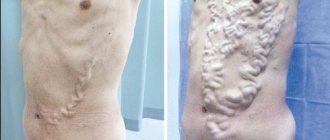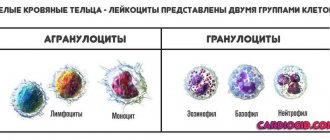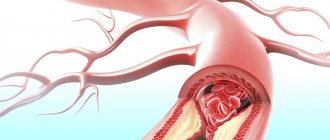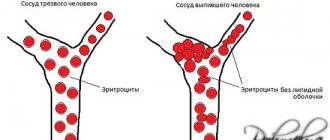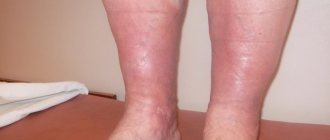Anemia is a common condition in women; the main sign of pathology is a decrease in hemoglobin levels in the blood. It cannot be called an independent disease, but rather a syndrome of many diseases and at the same time the cause of many dangerous conditions.
Low hemoglobin levels are often observed in women
In colloquial speech, anemia is often called anemia. This is due to a decrease in the number of red blood cells in the blood and the resulting oxygen deficiency. Women, both young girls and ladies over 40 years old, are especially susceptible to this pathological condition. Most often this concerns pregnant and lactating young mothers, whose bodies do not have enough strength for themselves and for the child.
Types of anemia
Based on severity, anemia can be divided into three groups:
- 1st degree, when the deviation of the hemoglobin level from the norm is less than a fifth;
- 2 degrees, in which the hemoglobin level is 20–40% below normal;
- 3 degrees, when the deviation exceeds 40%.
The gradation of severity is expressed in relative terms, because the normal level of hemoglobin in the blood varies depending on gender and age.
Depending on the reasons underlying anemia in women, the following types are distinguished:
- iron deficiency;
- aplastic;
- posthemorrhagic;
- hemolytic;
- folate deficiency;
- with B12 deficiency.
Iron deficiency anemia is caused by a lack of iron in the body. This may occur due to an increased need for it, for example, during the period of active teenage growth or pregnancy. It is often associated with eating disorders, diets that lead to insufficient intake of this element.
Aplastic anemia is caused by a disease of the hematopoietic system associated with damage to bone marrow cells. This is the most severe form of anemia, which is fatal in 80% of cases. But it is extremely rare.
Posthemorrhagic anemia is associated with serious blood loss, which could be caused by internal or external bleeding, resulting from injury or exacerbation of chronic diseases, such as stomach ulcers. In women, it often occurs with gynecological diseases accompanied by uterine bleeding.
Hemolytic anemia occurs when the life cycle of red blood cells is shortened. This type of pathology is very rare and can also be hereditary or acquired.
The last two types of anemia are associated with a deficiency of folic acid and vitamin B12 in the body, respectively. The lack of these substances leads to disruption of the normal process of red blood cell maturation, which is enhanced in the presence of aggravating factors. This influence includes pregnancy, increased physical and mental stress, and chronic diseases.
Iron deficiency is common in pregnant women
Causes of illness in men
Anemia occurs due to a decrease in the level of red blood cells in the blood, which leads to a decrease in the amount of hemoglobin. The syndrome in most cases develops in women due to physiological characteristics. In men, anemia occurs only in 2-3% of cases. The most common causes of pathology include:
- excessive blood loss caused by internal bleeding, injury or surgery;
- blood-destructive processes occurring inside blood vessels or some organs (liver, spleen);
- disruption of the bone marrow, which produces red blood cells.
In addition, there are factors that often cause anemia in men:
- Diseases of the gastrointestinal tract in which the absorption of iron is impaired. The risk group includes people suffering from gastritis, erosions or ulcers of the stomach or duodenum, and colitis.
- Improper nutrition, as a result of which the body does not receive the required amount of microelements and vitamins.
- Genetic predisposition, for example, hemophilia, transmitted through the male line.
Causes of anemia
The condition of insufficient hemoglobin can be accompanied by many pathologies, each of which has its own causes and aggravating factors. But we can identify a number of common causes of anemia that cause disturbances in a woman’s body:
- heredity;
- eating disorders;
- increased mental and physical stress;
- some conditions accompanied by an increased need for nutrition of body cells;
- negative environmental factors, ecology;
- chronic diseases and their exacerbations;
- past infectious diseases.
In women over 40 years of age, anemia can be caused by hormonal changes, a slowdown in metabolism, and the development of cancer. During this period, you should be especially attentive to your health and prevent existing chronic ailments from becoming neglected.
Depending on the severity and nature of the causes of anemia in adult women, symptoms and treatment methods will vary. Both errors in lifestyle and nutrition, as well as dangerous diseases, can lead to a pathological condition. Therefore, when the first suspicious signs appear, you should consult a doctor.
Treatment
To cure anemia, it is necessary to eliminate the cause of the pathology. If it develops against the background of another disease, the doctor prescribes treatment, the purpose of which is to eliminate the main problem. At the same time, the patient is treated with iron-containing drugs to increase the amount of hemoglobin to normal levels.
Important information: How hypochromic iron deficiency anemia is treated in adults, its symptoms and proper dietary nutrition for IDA
If anemia in men develops due to large blood loss, then emergency surgery is often performed to stop the bleeding. In this case, a blood transfusion is performed. In addition, the doctor prescribes drug therapy.
Anemia is treated in a hospital. After the amount of hemoglobin rises to a normal value, the patient is discharged home. Further therapy is carried out at home with strict adherence to the recommendations prescribed by the doctor. You should also undergo periodic tests for control.
Symptoms of anemia
Anemia may not have pronounced symptoms for a long time, which is why it is easily confused with ordinary malaise and fatigue. Some forms of anemia also have specific symptoms. The following are common signs of anemia in women:
- weakness and malaise;
- increased fatigue;
- decreased ability to withstand physical activity;
- dizziness;
- drowsiness;
- changes in taste sensations;
- sweating;
- shortness of breath;
- increased heart rate;
- difficulty swallowing;
- darkening of the eyes and fainting;
- deterioration of hair and nails;
- menstrual irregularities;
- decreased appetite.
There are also a number of specific symptoms that appear with certain types of anemia:
- with posthemorrhagic anemia, pale skin, low body temperature, vomiting, and digestive disorders are observed;
- with the iron deficiency type, tinnitus, muscle weakness, flaking of the skin, and cyanosis under the eyes are observed;
- hypoplastic anemia is characterized by ulcers in the mouth, nose, and skin;
- with the hemolytic form, there are signs of liver dysfunction, enlarged spleen, chills;
- With a deficiency of vitamins and anemia, digestive disorders, poor memory and coordination are expressed.
The severity of symptoms depends on the severity and duration of the pathological condition. Therefore, only professional diagnostics can determine the presence of a problem.
Main symptoms of anemia
Anemia, resulting from a violation of blood transport functions, causes changes in organs and systems. First of all, attention is drawn to the condition of the skin and mucous membranes. The most visible symptoms of anemia in men are as follows:
- The blush on the cheeks disappears or noticeably fades.
- The skin and mucous membranes acquire a yellowish tint.
- Cracks appear and heal poorly in the corners of the mouth.
- The skin on various parts of the body peels off, becomes dry and flabby.
- Swelling of the face and legs is observed, especially towards the end of the day.
- Nails peel and crumble, and grooves appear on them.
- Hair splits and falls out.
A decrease in oxygen delivered by blood to various tissues leads to ischemia of nerve cells. This negatively affects brain function. As a result, symptoms of nervous system disorders appear in the form of:
- dizziness,
- loss of coordination,
- visual disorders,
- headaches of random localization,
- sudden fainting states,
- memory loss.
The heart muscle is sensitive to oxygen starvation. Chronic anemia, disrupting the regulation of blood pressure, upsets the functions of the myocardium. The symptoms of this disorder are expressed as follows:
- rapid heartbeat and pulse (tachycardia) at rest or with minor physical exertion;
- chest pain accompanied by a feeling of lack of air;
- shortness of breath when performing usual work;
- heart rate instability.
Anemia affects not only vital organs, but also all other tissues. Additional signs of anemia in men include:
- muscle weakness;
- disturbance of smell and taste;
- drop in blood pressure;
- difficulty swallowing;
- belching, nausea, feeling of heaviness in the stomach.
Diagnosis of anemia
If you suspect anemia, you should consult a physician. He will prescribe a general and biochemical blood test, which will accurately determine the presence and severity of the disease.
To determine the type and causes of pathology, an examination of the digestive tract, skin, heredity and medical history is carried out, if necessary.
The type of anemia can only be determined by a doctor based on an analysis of the collected data. Depending on the type and causes, an individual treatment strategy will be selected. If there are risk factors for anemia or evidence of the disease in the past, it is necessary to monitor hemoglobin levels at least once a year.
To treat anemia, use medications containing iron.
Diagnostics
A doctor may suspect anemia during a routine examination based on the patient's appearance and complaints. The main role in the diagnosis of anemia belongs to a general blood test, which determines the level of hemoglobin. To obtain a more detailed result, a full analysis should be carried out. Using the latter, the color indicator, the average amount of hemoglobin in a red blood cell, as well as the number of reticulocytes - cells that allow one to judge the functioning of the bone marrow - are determined.
Since hidden bleeding is detected inside the gastrointestinal tract, the following examination methods are used for adult patients to identify the condition of the stomach and intestines:
- fibrogastroscopy,
- fibrocolonoscopy,
- sigmoidoscopy,
- irrigoscopy.
Treatment of anemia
In general, treatment comes down to combating iron deficiency in the body. Sometimes a simple diet is enough for this, and in some cases serious drug therapy is necessary. An important condition for successful treatment is eliminating the root cause of this condition.
Therefore, the treatment algorithm boils down to the following:
- Determination of the cause and its elimination, treatment of the underlying disease.
- Identification of the stage of anemia and the required degree of therapeutic intervention.
- Drawing up a diet and proper nutrition plan.
- Prescription of iron supplements and agents that improve its absorption.
Drug therapy usually takes from several months to six months. Iron-containing products are used in different forms of release. In the most severe cases, it is recommended to use injections.
Forms of pathology
Anemia has a variety of manifestations. Correct diagnosis determines one or more forms of pathology that occur in a particular situation:
- Iron deficiency (iron deficiency in the body; the most common). In addition to disorders of the skin and its appendages, appetite decreases and the body weakens. The papillae of the tongue atrophy (photo below), and there is a tendency towards inedible substances: clay, chalk and others.
- Megaloblastic (lack of cyanocobalamin and folic acid in the body). The nervous and digestive systems are affected. Coordination is impaired, motor activity decreases, and there is a decrease in the intellectual activity of the brain.
- Posthemorrhagic. There is a history of diarrhea and bloody vomiting.
- Hemolytic (destruction of red blood cells). The temperature rises, the liver and spleen enlarge.
- Hypoplastic (the production of red blood cells in the bone marrow is impaired). The main manifestation is a low number of red blood cells. Lymph nodes enlarge and immunity decreases.
The success of further treatment depends on correct and timely recognition of the form of anemia.
Nutrition for anemia
Proper nutrition for anemia in women will allow you to cope with a low stage of anemia without the use of special medications. Iron is found in both meat and plant foods. However, anemia is more common among vegetarians.
The main recommendation for anemia is to include a large amount of animal protein in the diet. To do this, eat the following foods more often:
- red meat (veal, beef);
- beef liver;
- Fish and seafood;
- eggs and dairy products.
But many plant foods are rich in iron. Legumes and cereals are especially useful: buckwheat, oatmeal, wheat, barley, rice. Fruits and vegetables are healthy whole and in freshly squeezed juices.
Freshly squeezed juices are beneficial for anemia
Of particular note are the pomegranate and beetroot juices. You need to be careful with the latter because of its high biological activity. The use of fresh juices must be agreed upon with a gastroenterologist.
The following types of fruits are rich in iron:
- apples;
- grape;
- pomegranate;
- peaches;
- citrus;
- persimmon.
Healthy foods include red and orange vegetables: beets, carrots, pumpkin, tomatoes. Berries, nuts and dried fruits are also recommended. It is advisable to drink herbal or berry tea, and avoid coffee altogether.
You should not eat junk food, fried, spicy or fatty. It is necessary to adhere to general recommendations for a healthy diet and lifestyle. It is also necessary to remember that in order to absorb the iron entering the body, a sufficient amount of vitamins is necessary. The main vitamins involved in metabolic processes include folic acid, vitamin C, as well as B6 and B12.
Vitamin C also plays an important role in the normal functioning of the immune system. Its sources are not only citrus fruits, but also rose hips, greens, cabbage, currants, sea buckthorn, viburnum, and kiwi.
How to suspect you have anemia?
Each person can focus on their own condition, because anemia makes itself known by a number of signs and symptoms. These may include problems such as dizziness when you get out of bed or a chair, armchair, etc., tachycardia due to increased work of the heart muscle, weakness, shortness of breath, which manifests itself during various physical activities, the appearance or exacerbation of , if present, angina pectoris, brittle nails, spoon-shaped nails, active hair loss and pale skin, jaundice.
If disturbing signals appear, you should contact a specialist as soon as possible to undergo research. This will allow the situation not to be left to chance, and in some cases will even save a person’s life.
Folk remedies for treating anemia
Folk remedies for the treatment of anemia are designed to increase hemoglobin levels and improve iron absorption. They cannot cure serious diseases that are the causes of the painful condition. Therefore, they are used as an addition to increase the effectiveness of the main treatment.
To increase hemoglobin, several recipes can be recommended:
- Strawberry infusion. It is made from dry berries, which are poured with a glass of boiling water and infused for several hours. After this, it is consumed once a day.
- Garlic tincture is made with alcohol, so it is not suitable for women during pregnancy and lactation, as well as for children. Garlic has high biological activity, strengthens the immune system and improves metabolism. The mixture of garlic and alcohol is infused for 3 weeks, after which 15–20 drops are taken, dissolved in a glass of milk.
- Rosehip decoction in any form. You can brew the berries you picked yourself or purchase ready-made tea for brewing at the pharmacy.
- Oatmeal decoction. The cereal is boiled at the rate of a glass per liter of water to a mass similar to jelly. After this, it is filtered, diluted with milk and boiled again. Honey is added to it before use. You do not need to take it all at once, but two or three times during the day.
Rose hips contain a high percentage of iron. Recommended for anemia
Dangerous consequences of anemia
As a result of a long-term pathological condition, negative health consequences of anemia may occur, even if its degree is low:
- decreased immunity and frequent illnesses;
- insomnia;
- exposure to stress, emotional instability;
- frequent inflammation of the mucous membranes;
- swelling;
- disruption of the heart and blood vessels;
- liver diseases;
- digestive problems;
- oxygen starvation of the brain;
- dry skin, brittle nails and hair.
These are the consequences of directly reduced hemoglobin. It is also important to remember that this condition can be caused by serious systemic disorders. Therefore, the lack of treatment will lead to their worsening and in some cases may cause irreversible deterioration in health.
For women, anemia is a common phenomenon, especially often accompanying pregnancy, adolescence and gynecological diseases. Anemia has dangerous consequences, especially during pregnancy. At the first signs of pathology, it is necessary to correct the diet and lifestyle. Controlling these two aspects is the best way to prevent it. It is also necessary to lead a healthy lifestyle with sufficient physical activity and spend more time in the fresh air.
Causes of pathology
We can identify 3 main reasons:
— Increased consumption of red blood cells. Red blood cells are cells that carry hemoglobin. In some situations, the body requires too many red blood cells, for example during bleeding, donation, dialysis, pregnancy. In fact, it is often possible to suspect internal bleeding based on reduced hemoglobin, which has not yet manifested itself in any way.
— The body produces few red blood cells. This happens with a deficiency of iron, vitamin B12, folic acid, leukemia, and blood diseases.
- Internal hematomas.
Question answer
Is it dangerous to take iron supplements if you have anemia? If you see reduced hemoglobin in a blood test, then do not rush to eat apples and drink liters of pomegranate juice. You need to urgently contact a therapist. His task is to find the cause of anemia in order to correct the situation in time. Many patients become hostages of a “long search” and undergo many different tests: FGDS, colonoscopy, ultrasound, blood tests, consultations with a gynecologist, urologist, and so on.
In fact, the first thing your doctor should do is give you a complete blood count and determine your mean erythrocyte volume (MCV). Today it is determined by an analyzer that is available everywhere. The MCV indicator determines in which direction to look for the cause of the decrease in hemoglobin.
Let me give you an example. If MCV < 80, then such anemia is called microcytic and most often indicates iron deficiency, and it is necessary to look for the cause in this direction. Don’t forget to ask girls and women about unusual taste preferences (chalk, for example) and clarify what unusual smells give pleasure (for example, fresh lime, gasoline). If the MCV is >100, this may indicate a lack of vitamin B12, liver disease, or simple helminthiasis.
Some people mistakenly think that anemia should be treated by hematologists. In fact, they are connected only when there is a suspicion of blood diseases, or in case of microcytic anemia with excess iron in the blood.
Not iron health. What happens if anemia is not treated Read more


